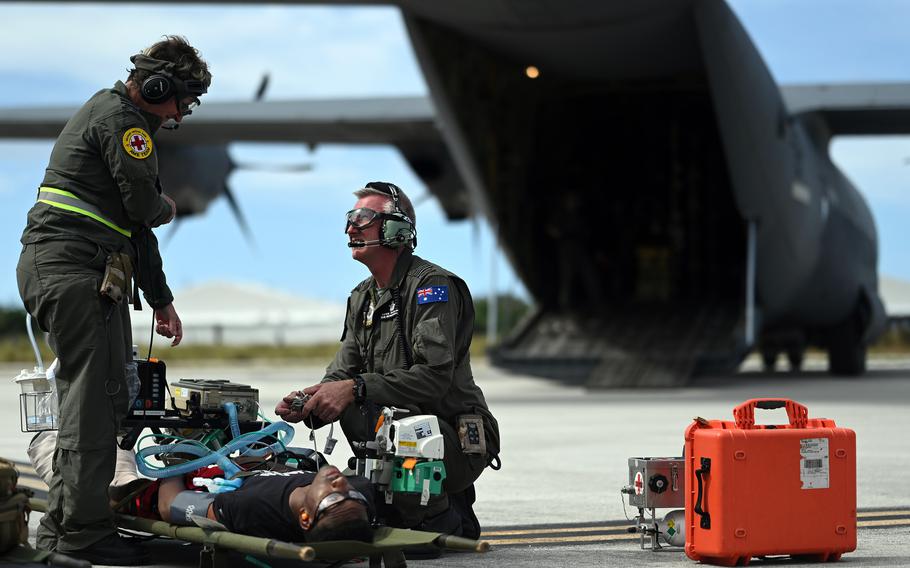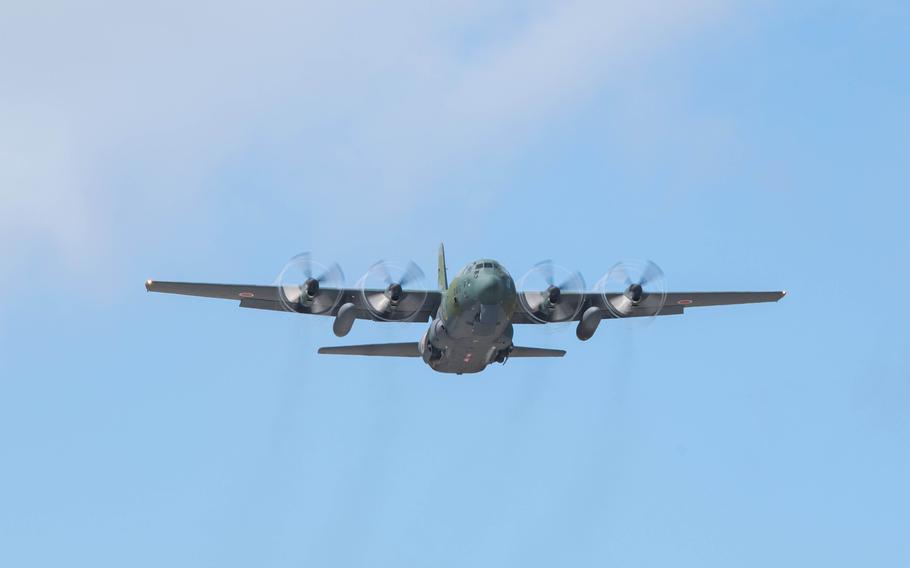
Royal Australian Air Force medical officers treat a simulated patient during a mass casualty scenario as part of Cope North 24 at Andersen Air Force Base, Guam, Feb. 11, 2024. (Gerald Willis/U.S. Air Force)
An annual multinational Air Force exercise on Guam concluded Friday after nearly three weeks of training missions, from aerial refueling to simulated air combat.
Cope North kicked off Feb. 5 at Andersen Air Force Base with an “elephant walk,” a runway parade of aircraft, and wound down Thursday with a static display of eight aircraft and their crews, according to 36th Wing spokeswoman 1st Lt. Ariana Wilkinson.
“We wanted to give the opportunity to Andersen family members and anyone within the community with base access to come out and see the aircraft that took part,” she said by phone Friday. “Just to let them get up close and personal and engage with our allies and partners.”
Aircraft on display included two airlifters, an Australian C-27 Spartan and a French A-400 Atlas; a Japanese Mitsubishi F-2 fighter jet; and a U.S. KC-135 Stratotanker aerial refueler, according to Wilkinson.

A Japanese C-130H Hercules taking part in the Cope North exercise lifts off from Andersen Air Force Base, Guam, Feb. 16, 2024. (Tylir Meyer/U.S. Air Force)
This year’s Cope North focused on NATO’s agile combat employment doctrine, which involves operating from major airfields and dispersed locations. More than 2,400 personnel from the U.S., Australia, Canada, France, Japan and South Korea took part.
The last of them were preparing Friday to head home, Wilkinson said.
The joint force planned to fly 1,400 missions with about 85 aircraft, according to a Pacific Air Forces news release in January.
“We’re working out of these airfields; we’re essentially able to pick up and move out of these spokes and hubs,” Wilkinson said.
The multinational coalition flew numerous missions, including a simulated aerial battle, from six airfields on three islands: Guam, Saipan and Tinian. The various scenarios allowed the U.S. to exchange information, tactics, techniques and procedures to “further integrate allied contributions for security and stability” in the Indo-Pacific, she said.
Other scenarios involved airlift logistics, command and control operations and large force deployments, according to Lt. Col. David Overstreet, the Air Force exercise director.
“We came together as one and will continue to expand on the lessons learned to ensure a free and open Indo-Pacific,” he said in a text message Friday.
In a Cope North first, U.S., Australian and Japanese officers led the exercise as a joint command. Using a new command-and-control system and an integrated communication network, the joint command shared responsibility for all aspects of the exercise, said Air Force Col. Henry Schantz, commander of 18th Operations Group.
“Building relationships remains key to successful deterrence. No one will win if they deter or fight alone,” he told Stars and Stripes by email Feb. 9, adding that the excitement was “palpable.”
The opportunity to work in a new command structure provided the opportunity for “a lot of lessons, but nothing that was insurmountable to solve,” according to Australian air force Group Capt. Kylie Green. One of the most obvious obstacles was communication, with certain words and acronyms meaning different things depending on the country, she said.
“Terminology is a part of it, you know, we’re separated sometimes by that common language,” she told Stars and Stripes by phone Feb. 6. “We have slightly different ways of doing things that gets us to the same outcome, so we’re just trying to identify what those points are so we can work together better and more effectively.”